Blog
The Essential Guide to AEDs in the Workplace: Compliance, Safety, and Best Practices
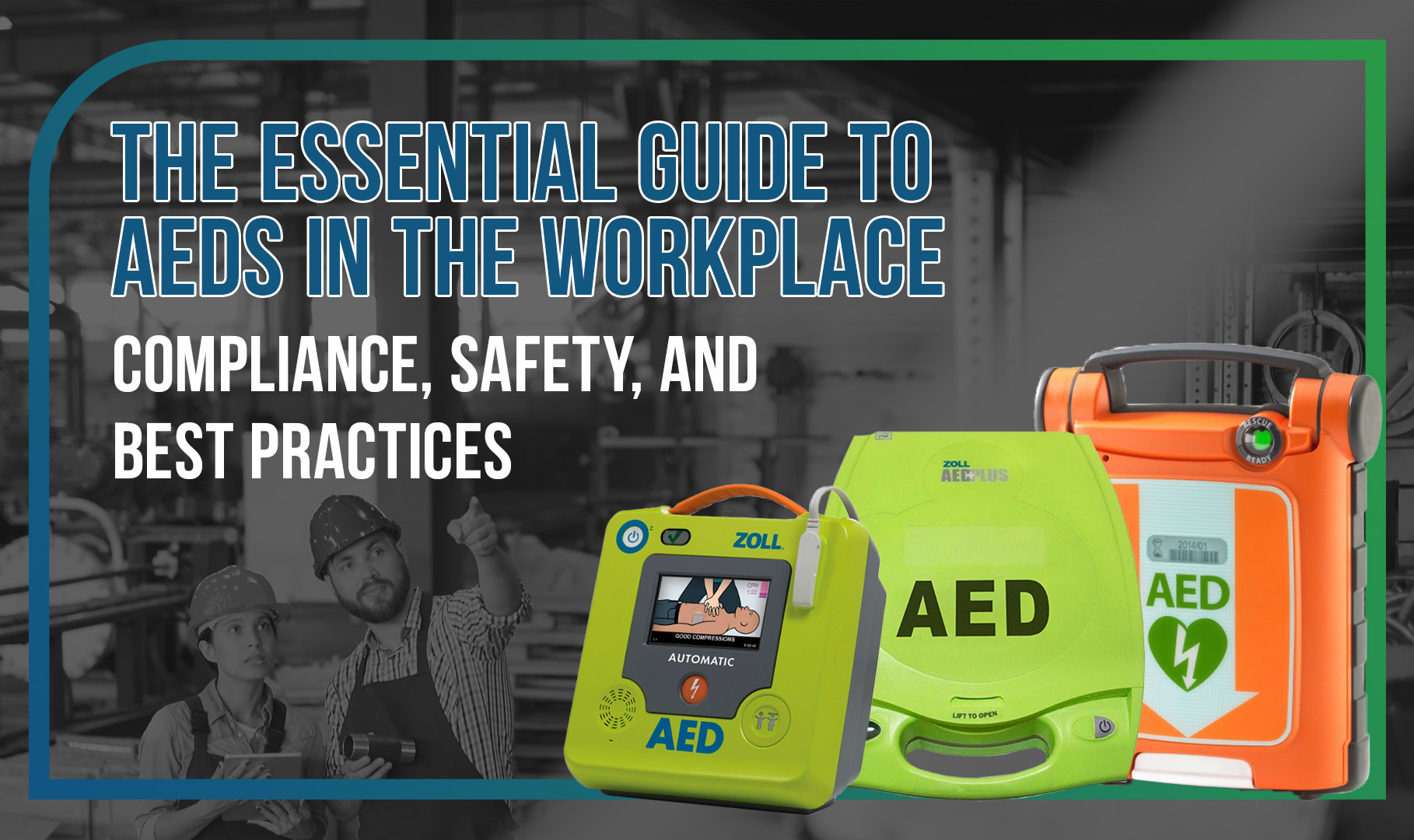
When it comes to cardiac emergencies, there are few medical advancements that have saved more lives than the Automated External Defibrillator (AED). Before this incredible invention, the only way to help a victim of cardiac arrest was to get them to a hospital as soon as possible, but even that small delay almost eliminated any chance of a full recovery. Now, AEDs are so user-friendly that defibrillation–previously only performed by licensed medical professionals– can be administered by any co-worker or bystander.
AEDs are so effective, that OSHA (along with many other accrediting bodies) have updated their safety recommendations for workplaces, citing evidence that 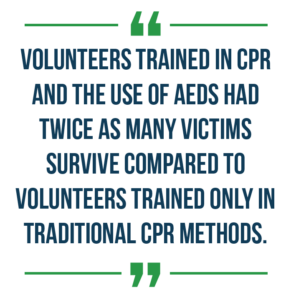
volunteers trained in CPR and the use of AEDs had twice as many victims survive compared to volunteers trained only in traditional CPR methods (source).
But how do you choose the AED that’s right for your workplace? We’ll be exploring industry compliance guidelines, AED features, and best practices so co-workers or bystanders can administer life-saving care, improving the chances that your any employee can return to normal heart rhythms and make a full recovery.
Why Equip Your Workplace with an AED?
Heart disease has been identified as a public health crisis in America. The American Heart Association reported more than 356,000 out-of-hospital cardiac arrests annually in the U.S., nearly 90% of them fatal (source). That’s nearly 1,000 people experiencing this life-threatening medical emergency every day. Workplaces must to be ready to provide life-saving medical equipment and training to their workers.
Workplaces that require manual labor are at a higher risk for cardiac emergencies, as physical exertion can trigger underlying heart issues in even the healthiest-appearing employees. A quick response is essential to reduce the risk of a fatal cardiac emergency. AEDs are an important aspect of meeting industry standards and best practices to keep your workers safe from sudden cardiac arrest (SCA).
Industry Safety Recommendations
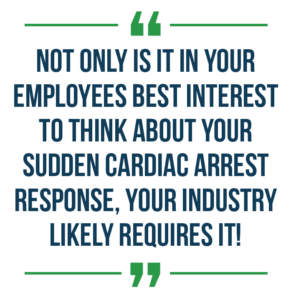 Not only is it in your employees best interest to think about your sudden cardiac arrest response, your industry likely requires it! OSHA’s guidelines for general industry states that “in the absence of an infirmary, clinic, or hospital in near proximity to the workplace which is used for the treatment of all injured employees, a person or persons shall be adequately trained to render first aid. Adequate first aid supplies shall be readily available (1910.151(b)).” CPR and first aid classes endorsed by the Red Cross are readily available, cost-effective, and an easy way to meet this aspect of OSHA recommendations.
Not only is it in your employees best interest to think about your sudden cardiac arrest response, your industry likely requires it! OSHA’s guidelines for general industry states that “in the absence of an infirmary, clinic, or hospital in near proximity to the workplace which is used for the treatment of all injured employees, a person or persons shall be adequately trained to render first aid. Adequate first aid supplies shall be readily available (1910.151(b)).” CPR and first aid classes endorsed by the Red Cross are readily available, cost-effective, and an easy way to meet this aspect of OSHA recommendations.
Simply purchasing an AED, however, may not be enough. In order to comply with accrediting body’s recommendations you may need to assign personnel to oversee the AEDs in your care. The American College of Occupational and Environmental Medicine (ACOEM) recommends consulting a qualified medical director to manage all medical aspects of your AED program. Their responsibilities may include writing a prescription for the AED and performing a case-by-case review each time the AED is used in the occupational setting. Additionally, a qualified person should be responsible for the program’s over-all administration and coordination activities, these duties are usually performed by your existing OSHA officer. Their duties may include providing quality assurance system to the AED program, ensuring compliance with industry-related and other regulatory requirements, and overseeing the education, training, and support for potential AED users.
An occupational AED program must comply with appropriate federal guidelines such as the Cardiac Arrest Survival Act and federal and state Public Access Defibrilator (PAD) legislation. As the details of state PAD legislation vary, a single corporate policy for a geographically separated organization may be insufficient unless it addresses all elements where the AEDs are placed. An occupational AED program should address and be in compliance with relevant medical practice insurance requirements and insurance programs for the organization, and for occupational physicians and nurses, and any programs affecting lay responders.
Common AED Features
An AED is an excellent solution for addressing workplace safety because AED training is included in most basic life support trainings required by OSHA. But anyone that has spent any time shopping for an AED knows that different models can come with rich features that can be overwhelming if you aren’t familiar with this equipment. Almost all AEDs will have the following features:
Voice Prompts: AEDs are designed to be user-friendly, especially for individuals without formal training. All AEDs provide voice prompts and clear instructions to guide the user through a shock and resuscitation.
Biphasic Waveform: AEDs deliver a biphasic waveform, which is an effective type of electrical shock for treating cardiac arrest. The shock is delivered through two pads placed on the victim’s body, creating a circuit for the electrical current to pass through the heart.
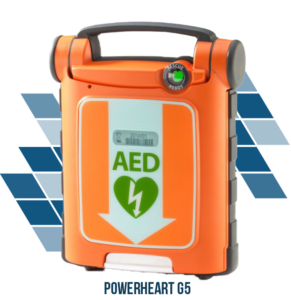 Language Options: Most AEDs offer multiple language options to accommodate users who may not understand the default language. A notable model with this feature is the Powerheart G5.
Language Options: Most AEDs offer multiple language options to accommodate users who may not understand the default language. A notable model with this feature is the Powerheart G5.
Warranty: When purchasing a new AED, it typically comes with a manufacturer’s warranty that can range from 5 to 8 years. MME’s recertified AEDs usually come with a 1-year warranty, with options to extend it or purchase a service plan.
Semi or Fully Automatic: AEDs are available in two types – semi-automatic and fully automatic. In the semi-automatic model, the user needs to press a shock button to deliver the electrical shock, while in the fully automatic model, the shock is delivered automatically, allowing the user to focus on chest compressions. 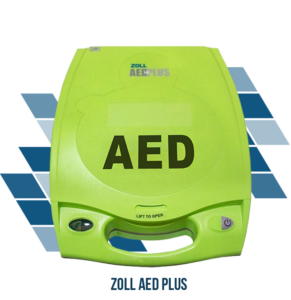 Some models come in either semi-automatic or automatic versions like the AED Plus.
Some models come in either semi-automatic or automatic versions like the AED Plus.
Self Checks: AEDs perform regular self-checks to ensure that all components are functioning correctly. If any issues are detected, the AED alerts the user through visible or audible alarms, allowing for timely maintenance.
Some AEDs will have additional specialty features such as:
Visual Prompts: Some AEDs include screens that display visual prompts to accompany the audio prompts. They can display animations to provide a step-by-step rescue process. The ZOLL AED 3 is a popular model that comes with this feature.
Professional Rescuer Tools
If your workplace has qualified medical professionals on scene, you might consider an AED with additional features for medically trained bystanders. The ZOLL AED 3 BLS is a premium version of the base model that includes many of these rich features.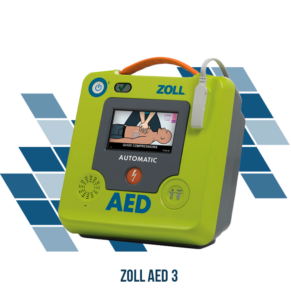
ECG Display: An ECG (Electrocardiogram) display shows the electrical rhythm and activity of the heart in a graph-style format. It can be helpful for medically trained individuals to track the victim’s heart rate progress.
Shock Levels: AEDs can deliver shocks using fixed energy or escalating energy. Fixed energy delivery means that all shocks delivered have the same energy level, usually around 300/350 joules. Escalating energy delivery provides increasing energy levels for subsequent shocks, starting from around 150 joules and reaching 300 joules or higher. The choice between fixed and escalating energy may depend on personal preference or specific needs.
Manual Override: Some AEDs have a manual override feature, which allows medically trained professionals to take control of the rescue process. This feature enables them to override automatic prompts and the analyzing stage to deliver a shock based on their professional judgment. Manual override is particularly useful for medical professionals in emergency situations.
No matter which AED you choose, it is important to keep them in readily accessible locations across your workplace. These life-saving devices along with CPR are the best way to improve the chances of survival from a cardiac emergency outside of a hospital.
